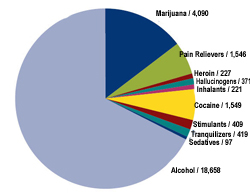
Why Can't They Just Stop? ©
© 2007 Home Box Office, Inc. All Rights Reserved.
Photo: Albert Watson/HBO
Two NIH institutes — the National Institute on Drug Abuse (NIDA) and the National Institute on Alcohol Abuse and Alcoholism (NIAAA) — have joined with HBO to reveal startling new advances in the fight against alcohol and other drug addiction.
The personal and family tragedies related to addiction are heartrending and, quite often, desperate. The struggles to break addiction and restore lives are uniquely challenging. And the scientific breakthroughs now taking place to help understand, prevent, and successfully treat addiction are nothing short of astonishing. Two NIH institutes that are already on the forefront of research into drug and alcohol addiction recently joined with cable TV network HBO to present an unprecedented multi–platform film, TV, and print campaign aimed at helping Americans understand addiction as a chronic but treatable brain disease. The eye-opening documentary, Addiction, first aired on HBO in March and is one part of the campaign. Developed with funding from the Robert Wood Johnson Foundation, Addiction and related video and print materials seek to help Americans understand addiction as a chronic yet treatable brain disease and spotlight promising scientific advancements.
Many Americans today do not yet understand why people become addicted to drugs or how remarkable scientific advances are literally redefining the arena of addiction, notes Nora D. Volkow, M.D., Director of the National Institute on Drug Abuse (NIDA).

Nora Volkow, M.D., Director of the National Institute on Drug Abuse
Photo courtesy of NIH/NIDA
"Groundbreaking discoveries about the brain have revolutionized our understanding of addiction, enabling us to respond effectively to the problem," she says. "We now know that addiction is a disease that affects both brain and behavior. We have identified many of the biological and environmental factors and are beginning to search for the genetic variations that contribute to the development and progression of the disease."
With nearly one in 10 Americans over the age of 12 classified with substance abuse or dependence, addiction takes an emotional, psychological, and social toll on the country. The economic costs of substance abuse and addiction alone are estimated to exceed a half trillion dollars annually in the United States due to health care expenditures, lost productivity, and crime.
"The National Institutes of Health is proud to be part of this effort to educate Americans about the nature of addiction and its devastating consequences," says NIH Director Dr. Elias A. Zerhouni. "We especially appreciate the opportunity to inform the public about the scientific research that is transforming our understanding and treatment of addictive disorders."
"Addiction is a disease — a treatable disease — and it needs to be understood."
– Dr. Nora Volkow
Addiction is now understood to be a brain disease because scientific research has shown that alcohol and other drugs can change brain structure and function. Advances in brain imaging science make it possible to see inside the brain of an addicted person and pinpoint the parts of the brain affected by drugs of abuse — providing knowledge that will enable the development of new approaches to prevention and treatment.

Mark Willenbring, M.D., Director of the Division of Treatment and Recovery Research at the National Institute on Alcohol Abuse and Alcoholism (NIAAA) Courtesy HBO
Photo courtesy of NIH/NIAAA
"Media depictions of addiction are often very sensationalized," says Mark Willenbring, M.D., Director of the Division of Treatment and Recovery Research at the National Institute on Alcohol Abuse and Alcoholism (NIAAA). "This is an opportunity to support a more accurate depiction of addiction."
"Addiction is a disease — a treatable disease — and it needs to be understood," says NIDA's Dr. Volkow. "Our goal is for HBO's Addiction documentary and project to educate the public about this disease and help eliminate the stigma associated with it."
Dr. Volkow and Dr. Willenbring were featured in the HBO documentary, as were scientific research results and new understandings developed through the work of their respective institutes.
Currently, addiction affects 23.2 million Americans — of whom only about 10 percent are receiving the treatment they need. "HBO's project offers us the opportunity to directly acquaint viewers with available evidence-based medical and behavioral treatments," says NIAAA Director Ting-Kai Li, M.D. "This is especially important for disorders that for many years were treated outside the medical mainstream."
"This is an opportunity to support a more accurate depiction of addiction."
– Mark Willenbring, M.D.
Consisting of nine segments, the film presents an encouraging look at addiction as a treatable brain disease and the major scientific advances that have helped us better understand and treat it. From emergency rooms to living rooms to research laboratories, the documentary follows the trail of an illness that affects one in four families in the United States.

Source: Substance Abuse and Mental Health Services Administration,
2005 National Survey on Drug Use and Health
Click on the chart for a larger image.
One segment, "The Adolescent Addict," explains that the adolescent brain differs from the adult brain because it is not yet fully developed. According to NIDA's Dr. Volkow, adolescent brains may be more susceptible to drug abuse and addiction than adult brains. However, because it is still developing, the adolescent brain may also offer an opportunity for greater resilience. Although treatment can yield positive results, many families are unwilling to look outside the home for help due to concerns about stigma.
Medications for use in treating alcoholism also are a focus of the program, including a segment on topiramate, under study by NIH-supported researchers at a clinic in Charlottesville, Virginia. At present, there are three FDA-approved medications available to treat alcohol dependence: the older aversive agent disulfiram, and two newer anti-relapse medications. Naltrexone, available by tablet or monthly injections, interferes with drinking reward and reinforcement, and acamprosate works on multiple brain systems to reduce craving, especially in early sobriety. According to NIAAA's Dr. Willenbring, these medications are not addictive and can be helpful adjuncts to treatment.
On the Web
- www.hbo.com/addiction/
This HBO Addiction interactive companion Web site allows visitors
to customize information for their specific needs, with a special emphasis on treatment options. The site features original content by the nation's leading experts in the science of addiction and addiction treatment, all 14 films in chaptered form, and comprehensive informational tips and resources. - www.drugabuse.gov
The Web site for the National Institute on Drug Abuse (NIDA) contains information on all facets of drug abuse, as a part of NIDA's mission to lead the nation in bringing the power of science to bear
on drug abuse and addiction. - www.niaaa.nih.gov
The Web site for the National Institute on Alcohol Abuse and Alcoholism contains research, resources, and related materials on the institute's work in the fight against alcohol abuse and alcoholism.
"There is a lot of exciting new scientific research information and treatments that we need to get out to the public," says Dr. Willenbring. "I think that we are on the cusp of a paradigm shift in the treatment of alcohol abuse."
The Addiction project also includes 13 short feature films from different directors on innovative family training and treatment approaches, interviews with leading experts, successful drug court programs that reduce relapses and re-arrests, and dealing with the dynamics of a disease that sometimes requires as much investment from family and community as it does from the individual struggling to recover. A comprehensive four-DVD set of the documentary and the 13 short films is available nationally.
NOTE: Although the dangers of nicotine addiction were not a part of this study, tobacco's impact on the health of Americans will be included in future issues.
